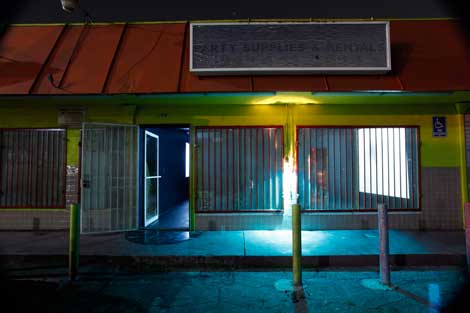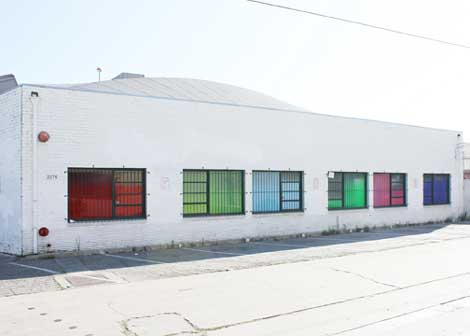When I arrive at Night Gallery to meet gallerists Mieke Marple and Davida Nemeroff, behind the front desk are champagne bottles and other artifacts leftover from “Sexy Beast,” the Planned Parenthood Los Angeles (PPLA) benefit/art auction. The event, which took place at the Theatre at Ace Hotel, was chaired by the two women. I meander twice through the gallery’s current show, “Trains,” and then stumble onto an informal workspace where business partners Marple, 28, and Nemeroff, 33, are seated at a black, chrome-bordered table in leather Eames swivel chairs. After introductions are made, Nemeroff mentions that “Sexy Beast” raised $550,000 for PPLA; the two women seem hugely satisfied, albeit a bit tired.
Nemeroff is a tall, curly-headed, striking brunette with a commanding presence and a frank manner. In addition to running Night Gallery with Marple, she is a photographer and has a show in November at Young Art in Los Angeles. She came up through the Toronto music scene, listening to garage rock, punk and other genres. The Canadian-born artist was something of an informal band photographer for The Constantines, and is credited with photos, album covers and artwork for numerous bands. A transplant from New York City, where she earned her MFA from Columbia in 2009, Nemeroff moved to Los Angeles in July of that year.
Marple is slighter, redhead and exudes a combination of world-weariness and intensity. She studied fine art at UCLA and worked for a number of artists before landing at 1301PE as a gallery assistant for about a year. She cycled through a number of ideas about what to do in the art world. “It ran the gamut,” she says, of wanting to be an artist, a curator and an art historian. “I didn’t really think I was suited to run a gallery. It wasn’t obvious to me. And then you just do it, and there’s no going back.”
After a very short stint as an assistant at a Chinatown gallery, Nemeroff founded Night Gallery in 2010, a year before she partnered with Marple. The ultra-cool off-the-grid guerrilla space that only operated nocturnally—located for its first three years near a Lincoln Heights strip mall—attracted attention in the press and an attentive art world following. Early in their partnership, the two discussed relocating to a stand-alone building, and nearly two years ago Night moved to its current space in an industrial district south of downtown. In spite of their aspirations for a bigger space and to achieve influence, it is clear they bring substantial idealism to their project. “That space,” Marple says, referring to the Lincoln Heights location “was very symbolic. It represented all of these ideas, being alternative, not going with the status quo,” adding that “to suggest change and to actually make change, you have to take those ideas and turn them into a reality through action.”
The social scene and the attendant party environment added to the gallery’s cachet. Although she expresses dismay at being tagged by the press as a party gallery, Nemeroff admits, when describing those early days, “I wanted to get fucked-up! I wanted to get fucked-up and look at art. Part of this was my acclimatizing to LA. I had just come from New York and I didn’t understand where people were going. I didn’t understand what they did. Now,” she says, “I want to be in bed at night.”
The moniker isn’t entirely undeserved, and even now, the gallery opens its doors to host raves, private events and temporary exhibits. But there is a discernible change as Marple and Nemeroff settle into their roles. Most of their experience comes from trial and error in directing the day to day operations and working to sell art. In her evolution Nemeroff has come to sharpen her interest and facility in the commerce side. She says she didn’t know how to sell art initially. “Someone is not going to walk in and say, ‘I want this.’ You have to sell it to them.”
Their ideas about how to run the gallery were informed by what Marple learned working at 1301PE and from working for artists who discussed their frustrations about how the art world worked. “I learned more about galleries by working for artists than I did working at galleries. I think we try to be artist-friendly.”
The relationship with collectors is equally important. Both Marple and Nemeroff say it takes a great deal of trust: trust, which takes time to build, has to exist between dealers and their collectors. Marple elaborates further, “At some point they don’t even have to know anything about the artist. They just trust the brand of the gallery so much,” that they believe in anyone the dealer brings to the table. “I think that happens when new artists join David Zwirner; their price goes up, people want it because they trust David Zwirner’s eye so much, just the brand and everything it represents. The gallery becomes this very powerful thing.”
The Zwirner Effect is something they aspire to but acknowledge they have not yet achieved. “We’ve convinced some people,” Marple says, “but we’re still trying to convince the majority of people.”
At the same time that they acknowledge an interest in being seen by the press as something other than a party gallery, Nemeroff critiques prevailing attitudes. “There is a feeling in the art world,” she says, “that art should remain highbrow and it should remain exclusive, not just in terms of who gets to own it, but who gets to see it or who gets to understand it, how it gets deconstructed, how it gets circulated in society.” Both she and Marple say that Night tries to open things up with their programming, saying that the raves, the parties, the restaurants and projects and shows that are two days long are integral to their success and a reflection of who they are.
“When Mieke and I partnered,” Nemeroff tells me, “we continued to run that [old] space for two years together. In that initial conversation, when we started talking about partnering, we did these projections of what we wanted and what we thought the future could be. And oddly, we wanted to get here, to the day after our first big benefit.”




